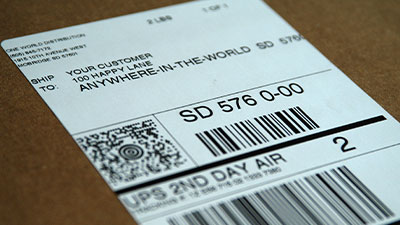In This Article:
Understanding Flat Rate Shipping
Flat-rate shipping is a method where the cost is fixed, irrespective of the package’s destination. Unlike traditional shipping methods that calculate rates based on distance, weight, and dimensions, flat-rate shipping offers a predictable pricing structure that simplifies logistics and budgeting.
This guide explores the different types of flat rate shipping so you can optimize your shipping fee structure for maximum profitability.
Flat Rate Shipping Among Carriers:
Carriers provide specific box sizes, each with its own flat rate. For example, if you’re using a USPS Medium Flat Rate Box, you’ll pay one set price whether your package weighs 1 pound or 20 pounds and whether it’s being shipped across town or across the country.
Flat Rate Shipping Offered by 3PLs:
In addition to flat rate shipping options provided by carriers, some 3PLs have the ability to offer flat rate shipping across a multitude of carriers, ensuring you always get the best rate and service. Technologically-advanced 3PLs, like One World Direct, have developed an algorithm that offers a flat shipping rate based on weight alone. Regardless of where your package is traveling, you receive transparent rates based on how quickly the package needs to be delivered, so you know exactly how much you need to charge customers for shipping fees.
Enhancing Your Shipping Strategy
Understanding the intricacies of first mile and last mile delivery can provide insights into improving your overall logistics efficiency.
In terms of inventory management during shipping, implementing effective lot management strategies like FIFO can ensure that your products are shipped in the order they were received, thus maintaining product quality and freshness.
Finally, when it comes to ecommerce businesses, selecting the right ecommerce platform is crucial. A suitable platform can streamline your operations, including managing flat-rate shipping options more efficiently.
Exploring Flat Rate Shipping Options Across Carriers
Carrier-Specific Options
Each major carrier—USPS, UPS, FedEx—offers unique flat-rate solutions tailored to different needs:
- USPS: Known for competitive rates on small to medium-sized packages domestically.
- UPS: Offers more extensive box sizes suitable for larger shipments.
- FedEx: Provides comprehensive international flat-rate options.
Box Options for Flat Rate Shipping
Several major carriers offer flat-rate shipping options:
- USPS (United States Postal Service): Offers a variety of box sizes such as Small, Medium, and Large Flat Rate Boxes.
- UPS (United Parcel Service): Provides UPS Simple Rate which allows for consistent pricing with five size categories.
- FedEx: Features FedEx One Rate for various standard box sizes.
Choosing the right carrier and understanding their specific flat rate offerings can help streamline your shipping process and control costs.
USPS Flat Rate Boxes:
USPS offers a variety of flat-rate box sizes that cater to different shipping needs. Here’s a breakdown:
- Small Flat Rate Box: Ideal for smaller items like jewelry or small electronics. Dimensions are 8 11/16″ x 5 7/16″ x 1 3/4″.
- Medium Flat Rate Box: Suitable for shoes, books, and small-sized packages. Available in two dimensions: Top-loading (11 1/4″ x 8 3/4″ x 6″) and Side-loading (14″ x 12″ x 3 1/2″)
- Large Flat Rate Box: Perfect for bulkier items or multiple smaller items combined. Dimensions are 12″ x 12″ x 5 1/2″.
UPS Flat Rate Boxes:
UPS also provides flat rate shipping options with a focus on medium and large-sized shipments, known as UPS Simple Rate:
- UPS Medium Flat Rate Box: Accommodates mid-sized items like apparel or larger electronics. Maximum size is up to a cubic foot.
- UPS Large Flat Rate Box: Designed for even bulkier items or multiple products. Maximum size is up to a cubic foot and a half.
Comparison Between Carriers' Offerings:
Both USPS and UPS offer distinct flat-rate shipping services tailored to varying needs:
- USPS: Generally more cost-effective for lighter and smaller packages, especially beneficial for ecommerce businesses dealing with frequent but smaller shipments.
- UPS: Excellent for larger packages where weight can be a significant factor. Offers competitive rates and reliable service.
Advantages of Specific Box Sizes for Different Shipments:
Selecting the appropriate box size can optimize your shipping strategy:
Small Boxes (USPS Small):
Advantages: Cost-effective for high-density, low-weight items.
Use Cases: Jewelry, small gadgets, accessories.
Medium Boxes (USPS Medium, UPS Medium):
Advantages: Versatile; fits most average-sized products.
Use Cases: Apparel, books, mid-sized electronics.
Large Boxes (USPS Large, UPS Large):
Advantages: Ideal for consolidating multiple items into one shipment.
Use Cases: Bulk shipments, larger electronics, mixed product bundles.
Understanding the nuances of each carrier’s flat rate options helps you select the most efficient and cost-effective solution for your shipping needs. However, it’s also crucial to consider sustainable practices in your shipping strategy. Implementing sustainable, eco-friendly fulfillment can significantly enhance your brand’s reputation while reducing environmental impact.
Furthermore, if you’re looking to streamline your operations and reduce logistics costs, understanding how to reduce logistics cost is essential. Partnering with a reliable third-party logistics provider can make this process much easier. But how do you find the right one? Our guide on how to choose a 3PL provider offers valuable insights.
Additionally, if you’re unfamiliar with the workings of third-party logistics and want to understand how a 3PL works, check out our guide to discover how 3PLs operate.
Benefits of 3PL-Offered Flat Rate Shipping for Ecommerce Businesses
When your 3PL offers flat rate shipping you gain transparency, which can be passed along to your customer base. Some key benefits include:
Cost Predictability
One significant advantage of flat-rate shipping from 3PLs is the fixed cost structure. Unlike traditional methods, where shipping fees fluctuate based on weight, distance, and dimensions, flat-rate shipping offers a consistent price. This predictability eliminates surprises at checkout, allowing you to manage your budget effectively.
Time Efficiency
Decision-making becomes faster when you don’t have to obtain quotes from various carriers and shipping zones. Flat-rate shipping removes the need for intricate shipping cost calculations, enabling quicker processing times and improving overall efficiency.
Attractive for Heavy Packages
Shipping heavy items can be prohibitively expensive with weight-based pricing. Flat-rate options like those offered by OWD are cost-effective for heavier packages, and often heavy item surcharges are already baked into the rates so there are no surprises after the packages leave the warehouse.
Free Shipping Promotions
Offering free shipping is a powerful incentive that enhances customer satisfaction. Flat-rate pricing allows you to absorb the shipping costs more predictably, making it easier to offer free shipping promotions without jeopardizing your profit margins.
Elimination of Shipping Zones
Flat-rate shipping simplifies logistics across different regions by eliminating the complexity of shipping zones. You no longer need to calculate varying rates based on geographic locations, allowing for a smoother and more straightforward fulfillment process.
In addition to these benefits, overnight shipping can also be integrated into your flat-rate strategy, providing customers with expedited delivery options while maintaining cost predictability.
The advantages of flat-rate shipping, such as streamlined operations and enhanced customer satisfaction, are clear. However, it’s essential to also consider some potential disadvantages that may arise in specific scenarios. By carefully adopting this method and being aware of its intricacies, your ecommerce business can leverage cost-effective shipping options and improve overall efficiency.
How to Use Carrier-Specific Flat Rate Shipping Effectively
Learn how to use flat-rate shipping with our detailed step-by-step guide for ecommerce businesses. This section will walk you through the process and offer tips for selecting the most suitable carrier based on your needs.
Step-by-Step Guide on Utilizing Flat Rate Shipping
1. Assess Your Shipping Needs
- Identify the types of products you typically ship.
- Determine average package weights and dimensions.
- Evaluate shipping frequency and volume.
2. Choose the Right Carrier
- Compare options from USPS, UPS, and FedEx.
- Look at pricing structures, delivery times, and additional services.
- Consider customer reviews and reliability.
3. Select Appropriate Flat Rate Boxes
Choose from various box sizes offered by each carrier:
- USPS: Small, Medium, and Large Flat Rate Boxes
- UPS: Flat Rate Box for Domestic Shipments
- FedEx: One Rate Packaging Options
Match box sizes with your typical product dimensions.
4. Calculate Costs and Benefits
- Use carrier-provided calculators to estimate costs.
- Compare flat rate prices against traditional shipping rates.
- Factor in potential savings for heavier packages or long-distance shipments.
5. Integrate Flat Rate Shipping into Your Ecommerce Platform
- Utilize carrier APIs or plugins to automate rate calculations at checkout.
- Update your shipping policy to reflect flat rate options.
- Ensure your fulfillment team is trained on packing procedures for flat rate boxes.
6. Monitor Performance
- Track shipping metrics such as delivery times, cost savings, and customer satisfaction.
- Adjust strategies based on performance data.
- Solicit feedback from customers regarding their shipping experience.
Tips for Selecting the Right Carrier Based on Business Needs
- USPS: Ideal for small to medium-sized packages; known for cost-effective options and reliable delivery within the U.S.
- UPS: Best suited for heavier items or international shipments; offers extensive tracking options and premium services.
- FedEx: Optimal for businesses requiring expedited shipping; provides a wide range of packaging solutions and robust customer support.
Understanding how flat-rate shipping works can streamline your logistics operations while offering predictable costs. By following these steps and selecting the right carrier, you can enhance both efficiency and customer satisfaction in your ecommerce business.
In addition, partnering with a 3PL who can leverage all major carriers to get you the most affordable and flexible flat rates could be a more favorable option. This unique service, offered by 3PLs such as One World Direct, eliminates the leg work on your end, and in turn allows you to focus on more significant tasks, such as product development and marketing.
Flat Rate vs. Standard Shipping: Which is Better?
Understanding the differences between standard shipping and flat-rate shipping offered by carriers is essential for optimizing your ecommerce fulfillment strategy. Each method has its own advantages and limitations that you need to consider.
Key Differences Between Standard Ground Shipping and Flat Rate Option
1. Pricing Structure
- Standard Ground Shipping: Pricing varies based on package weight, dimensions, and destination. Costs fluctuate significantly, making it harder to predict expenses.
- Flat Rate Shipping: Offers a fixed price regardless of destination within predefined limits. This method simplifies budgeting and ensures cost predictability, making it a popular choice among ecommerce businesses.
2. Carrier Offerings
- Standard Ground Shipping: Available through all major carriers including USPS, UPS, and FedEx. Provides flexibility in choosing the most cost-effective option for each shipment.
- Flat Rate Shipping: Typically provided by USPS with options like Priority Mail Flat Rate Boxes, and select services from UPS and FedEx.
Pros and Cons Depending on Package Size and Weight
Pros of Flat Rate Shipping
Cost Predictability:
- Eliminates surprise fees at checkout.
- Easier to incorporate into free shipping promotions.
Simplified Logistics:
- Standardized packaging options streamline packing processes.
- No need to calculate shipping costs based on varying factors.
Ideal for Heavy Items:
- Offers significant savings for heavier packages that would incur high costs under standard shipping.
Example: A 20-pound box shipped across the country can cost significantly more with standard ground shipping compared to a flat-rate box.
Cons of Flat Rate Shipping
Limited by Box Size:
- Only specific box sizes are available; may not accommodate all product dimensions.
- Can be inefficient for very small or lightweight items that could ship cheaper via standard methods.
Carrier Restrictions:
- Primarily offered by USPS with fewer options from other carriers, limiting flexibility.
Pros of Standard Ground Shipping
Flexibility in Packaging:
- No size restrictions beyond carrier limits; ideal for non-standard item dimensions.
- Branded packaging is an option
Potential Cost Savings for Light Items:
- Lighter packages or shorter distances often cost less than flat rate options.
Multi-Carrier Options:
- Ability to choose the most economical carrier per shipment.
Cons of Standard Ground Shipping
Variable Costs:
- Unpredictable pricing based on weight, size, and distance.
Complex Logistics:
- Requires more time to calculate costs and select appropriate services per order.
Both methods have their place in a comprehensive shipping strategy. You should evaluate based on package size, weight, and your business needs to determine which method maximizes efficiency and cost-effectiveness.
Economy Flat Rate Shipping Options
Economy flat-rate shipping is a great solution for small businesses looking to reduce their shipping costs while still providing quality service. Major shipping companies like USPS, UPS, and FedEx offer various affordable services designed specifically for small businesses, or for businesses selling inexpensive items.
Overview of Economy Services Offered by Major Carriers
Here’s a quick overview of the economy services offered by the major carriers:
- USPS: The USPS provides its Priority Mail Flat Rate service, which is a cost-effective option for domestic shipping. With flat-rate boxes ranging from small to large sizes, businesses can ship items at a fixed price regardless of weight or destination within the United States. This simplifies budgeting and planning.
- UPS: UPS offers its Simple Rate service, allowing businesses to ship packages across the country at flat rates. This service includes multiple box size options and competitive pricing that helps reduce overall shipping expenses.
- FedEx: FedEx’s One Rate service offers another reliable economy option. Similar to USPS and UPS, FedEx One Rate provides fixed pricing based on package size rather than weight or distance, making it a predictable and cost-effective choice.
Businesses leveraging economy flat rate shipping can focus more on growing their business rather than getting bogged down by complex logistics and fluctuating costs. Integrating these services into your existing fulfillment strategy can provide a competitive edge in today’s dynamic ecommerce landscape.
Add Your Heading Text Here
Challenges and Limitations with Carrier-Provided Flat Rate Shipping
Flat-rate shipping offered by carriers has some benefits, but it is not without its limitations. Understanding the disadvantages of this type of flat-rate shipping enables businesses to make informed decisions.
Situations Where Traditional Pricing Might Be More Beneficial
- Lightweight Items: Flat-rate shipping can be less cost-effective for lightweight items. For example, a small, lightweight package might cost significantly less with traditional pricing methods than the fixed rate of flat-rate shipping.
- Local Deliveries: If your business frequently ships within a localized area, traditional pricing models based on actual distance could offer noticeable savings over flat rate options that charge the same price regardless of distance.
- Oversized Packages: While flat rate options are advantageous for heavy packages, oversized items that do not fit standard flat rate boxes may incur additional charges or may not qualify for flat rate shipping at all.
Carrier-Specific Limitations
- USPS Flat Rate Boxes: The dimensions and weight limitations of USPS flat rate boxes may not suit all types of products. Businesses dealing with irregularly shaped or bulky items might find these constraints challenging.
- UPS and FedEx Restrictions: Both UPS and FedEx have their own sets of rules and restrictions regarding flat rate shipping, which might limit flexibility in packaging and shipment sizes.
Cost Implications
- Hidden Costs: While the fixed price aspect of flat rate shipping simplifies cost predictions, there may be hidden costs such as surcharges for residential delivery or extended areas that are not immediately apparent.
- Missed Savings Opportunities: Businesses focused solely on flat rate shipping might miss out on potential savings from promotional rates or volume discounts available through traditional pricing models.
Operational Considerations
- Standardized Packaging Requirements: The need to conform to standardized packaging sizes required by carriers offering flat rate services can necessitate additional operational adjustments, potentially complicating the fulfillment process rather than simplifying it.
Is Flat Rate Shipping Right for Your Business?
Several critical factors come into play when evaluating whether flat-rate shipping is suitable for your business. Understanding these elements ensures you make an informed decision that aligns with your operational needs and customer expectations.
Key Factors to Consider
- Shipment Weight and Size: Flat-rate shipping benefits businesses handling heavier items. If your products are bulky or dense, the cost savings can be significant compared to weight-based pricing models.
- Shipping Volume: Evaluate your average order size and frequency. High-volume shippers may find flat-rate options beneficial due to predictable costs, enhancing budget accuracy.
- Distance of Shipments: Businesses shipping nationwide or internationally often face varying rates based on zones or regions. Flat-rate shipping eliminates these discrepancies, offering a consistent fee regardless of distance.
- Customer Experience: Flat-rate shipping can enhance customer satisfaction by enabling free shipping promotions and eliminating unexpected costs at checkout. This transparency fosters trust and encourages repeat purchases.
- Fulfillment Efficiency: Simplified logistics through flat-rate options can lead to faster processing times and reduced handling errors, crucial for maintaining a competitive edge in ecommerce.
The Advantages of Choosing Flat Rate Shipping Through a 3PL Over Other Methods
Flat-rate shipping offers numerous advantages that can significantly benefit ecommerce businesses. Predictable costs, streamlined fulfillment, and increased satisfaction make it an attractive option. You eliminate the complexity of shipping zones, providing a seamless experience for your customers.
Assess your current fulfillment strategies to identify areas for improvement. Partnering with One World Direct, a 3PL who offers flat rate shipping, leads to more efficient operations and satisfied customers.
Plus, if you’re looking to add product personalization to increase profit and convert more visitors, explore our personalized-to-consumer fulfillment options. This includes engraving and embroidery on products, plus custom greeting cards at checkout.
Ready to optimize your shipping strategy? Book a consultation today with One World Direct, experts in D2C & B2B order fulfillment since 1994, and learn how flat rate shipping can lower your fulfillment costs effectively.
In This Article:
Subscribe to our Newsletter
Tincidunt urna mauris eu quam vulputate lobortis sit. Purus feugiat arcu nunc quisque massa ut.



























